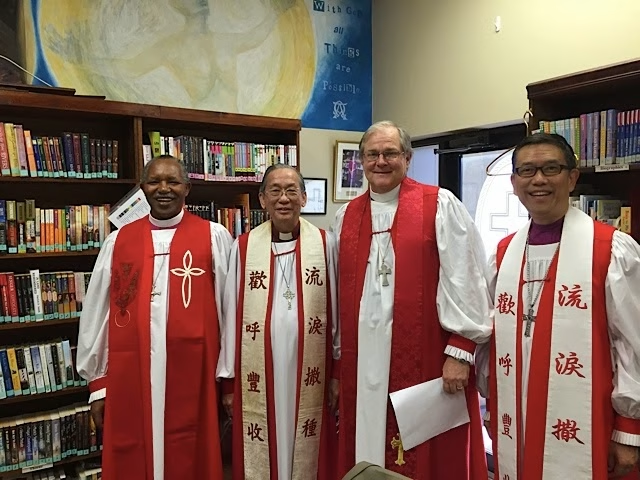Bishop Barnum says that in the mid-summer of 2011, “…our Chairman met in London with AMIA’s retired and founding archbishops (It was Archbishops Kolini, Yong, and Tay). It was here, as I understand it, that the concept of a new AMIA Missionary Society took shape out of a perceived concern that AMIA was suddenly vulnerable to the leadership changes in Rwanda. As this meeting took place, the vision of the Missionary Society — a real, tangible “option” — was as yet completely unknown to, and outside the counsel of, our own Rwandan Archbishop, Onesphore Rwaje.”
On August 31 2011, Chuck Murphy polled the AMiA Council of Bishops on options for their affiliation. Bishop Barnum recounts: “I was on a monthly AMIA Council of Bishops (COB) phone call when our Chairman presented us with “options.” He asked, 1- if we wanted to stay in Rwanda; 2- if we wanted to go to ACNA or, 3- if we wanted to start a new Missionary Society. He asked each of us to respond.”1 Bishops Barnum and Glenn were not in favor of leaving Rwanda. We don’t have a head count of what the other bishops voted to do, but given later events it appears that they gave Murphy the green light to start the Missionary Society.
In mid-September, before the next Rwandan House of Bishops meeting, the Rwandan bishops had a retreat where they were led by retired Bishop John Rucyahana and focused on reconciliation. This is said to have brought them closer together, perhaps fixing any disagreements between Bishop Alexis and Archbishop Rwaje.
What this looks like is:
- The financial arrangements of the 2001-10 period were now under scrutiny.
- The Rwandan House of Bishops would no longer rubber stamp decisions Chuck Murphy made, such as creating new bishops.
- So Murphy went outside of active clergy and sought to do what he wanted with the blessing of retired Archbishops.
Murphy moved from being submitted in theory to an actual Archbishop in Rwanda to getting the band back together with Kolini, Tay, and Young, all retired from their roles. He was picking and choosing bishops he knew had supported his ideas and who, in the case of Kolini, allegedly benefited financially from AMIA largess over the years. This was highly unorthodox in terms of Anglican polity, unusual even for the chaotic time in which it occurred. Further, it cut Archbishop Rwaje out of the loop entirely. Compare these actions to what Murphy had said the previous year about Rwaje’s election:
Many of you know that he is the Dean also of the Province of Rwanda, so he knows the entire Province, he travels with Kolini, he’s been with him through his entire tenure and everyone knows loves and respects him already. What you may also know, or want to know, is that he is very familiar with us. He’s been coming for Winter Conferences for five, six, seven years now, he’s very familiar with our culture, he’s done a graduate study at Fuller Seminary, he knows not only the province he knows the United States. He’s respected not only in the province he’s respected in Africa having been elected in 2003 to be Vice-Chair of the Council of Anglican Provinces of Africa, so we’ve got a remarkable leader for this next chapter and we’re all very excited about this.
I want to thank you again for your support in prayers, tell you how personally happy I am that this election has reached this conclusion and we had this man to be Archbishop Kolini’s successor.2
These sentiments did not survive contact with the man himself in his new role. Instead, Murphy turned back to Kolini, who was happy to oblige him.
